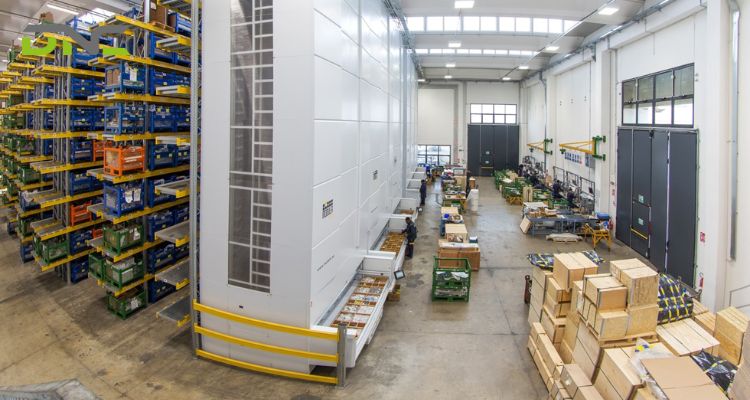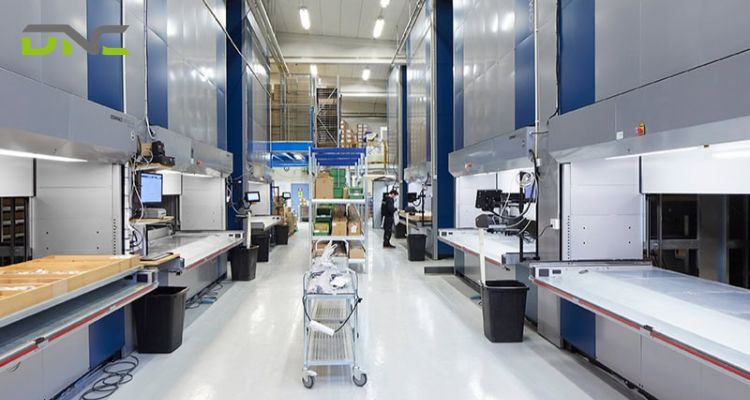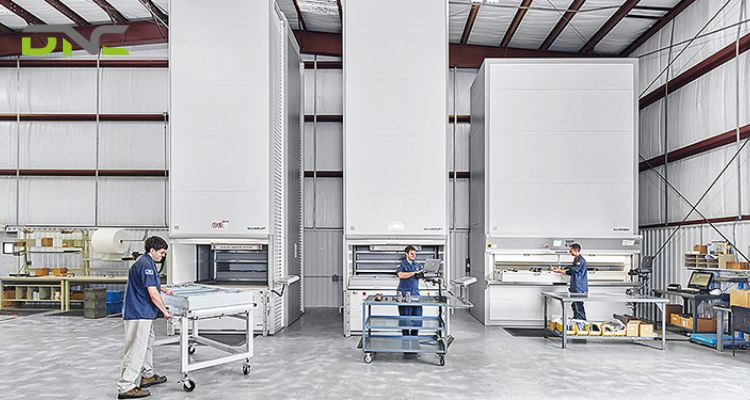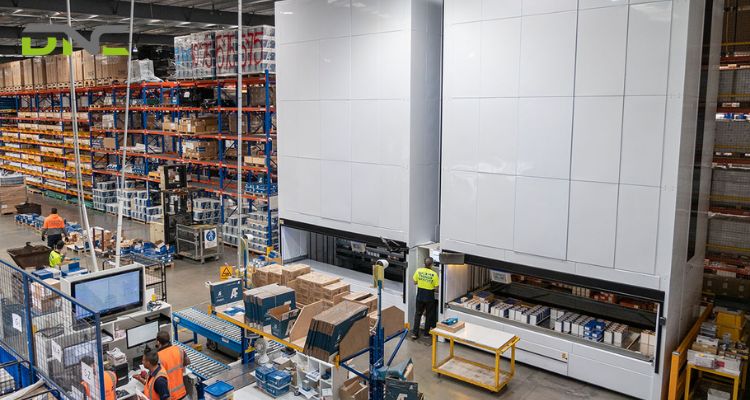Vertical Lift Modules (VLM): Complete Guide to Smart Warehouse Automation
A Vertical Lift Module (VLM) is an enclosed automated storage and retrieval system designed to maximize vertical space efficiency. It operates on a goods-to-person principle, automatically delivering trays containing stored items to an operator access point—eliminating the need for workers to walk through aisles or manually search for materials. Inside the unit, vertically arranged trays are managed by an extractor mechanism that retrieves and returns trays with precision, while inventory data is updated in real time.
Evolving from traditional paternoster systems, modern VLMs integrate advanced software, sensors, and warehouse management connectivity. These systems not only improve storage density and picking speed but also enhance workplace ergonomics and inventory accuracy, making them essential components of today’s smart warehouse environments.

What is the Vertical Lift Modules (VLM)?
Architectural Components and Operating Principles
Modern Vertical Lift Modules (VLMs) integrate advanced mechanical and electronic subsystems to deliver seamless, high-density storage and rapid retrieval performance. Each component plays a critical role in ensuring efficiency, reliability, and safety—working together to transform how materials are stored and accessed in industrial environments.
- Storage Column: The main structural frame, typically made of durable steel, with heights ranging from 3 to over 16 meters, depending on building and capacity requirements. This vertical configuration allows warehouses to utilize the full building height instead of limited floor area.
- Storage Trays: Serving as the primary load carriers, trays come in various heights (around 50mm to 800mm) to accommodate different item sizes. Dynamic storage algorithms automatically adjust spacing between trays, optimizing density and eliminating wasted vertical space.
- Extractor Mechanism: The core of the VLM system, this high-speed elevator-like device moves vertically to pick and deliver trays. Advanced extractors can reach speeds of over 2 meters per second, ensuring quick access and precise positioning even after millions of operating cycles.
- Access Openings: The ergonomic interface where operators interact with stored materials, typically positioned between 800mm–1200mm for comfort and safety. Features like light curtains, interlock systems, and optional dual access points enable safe, high-throughput operations.
Benefits of Implementing VLMs in Malaysian Operations
Implementing Vertical Lift Modules (VLMs) helps Malaysian businesses overcome warehouse space shortages, labor constraints, and efficiency challenges. These systems deliver significant gains in productivity, safety, and inventory control while supporting Industry 4.0 transformation.
- Maximizing Space Efficiency: VLMs use vertical height to achieve up to 85% space utilization, compared to 30–35% in traditional racking. By removing aisles and consolidating inventory, companies can cut warehouse footprints by up to 80%, avoiding costly expansion or relocation.
- Boosting Productivity: Automated goods-to-person retrieval eliminates walking and searching time, increasing picking speed by over 250%. Real-time tracking enhances accuracy to 99.9%, enabling faster and more reliable order fulfillment.
- Reducing Labor Costs: VLMs lower labor costs by up to 40% per unit handled while shifting roles from manual work to skilled technical operation. This helps address workforce shortages and reduce turnover.
- Enhancing Safety and Accuracy: Ergonomic design eliminates bending and lifting, cutting injury rates by up to 75%. Automated access control and digital tracking ensure secure, precise inventory management ideal for regulated sectors like pharmaceuticals.

Benefits of Implementing VLMs in Malaysian Operations
How Are VLMs Applied Across Key Malaysian Industries?
Vertical Lift Modules (VLMs) are transforming how Malaysian industries manage inventory, streamline workflows, and utilize warehouse space efficiently.
- Manufacturing and Automotive: VLMs improve tool and spare parts management, reducing retrieval time from minutes to seconds. Factories use line-side VLMs for just-in-time material delivery, boosting machine utilization and production flow.
- E-commerce and Third-Party Logistics (3PL): VLMs handle thousands of SKUs with high-density storage and rapid picking. Fulfillment centers achieve up to 60% floor space savings, 250% productivity gains, and 99.9% picking accuracy for faster, error-free order processing.
- Aerospace, Electronics, and Medical Devices: Cleanroom-compatible VLMs ensure ESD protection, automated traceability, and full compliance with AS9100, FDA, and MDA standards, ideal for precision manufacturing environments.
- Pharmaceutical and Healthcare: VLMs provide temperature control, expiration-date tracking, and restricted access for controlled substances—supporting regulatory compliance and eliminating medication errors.
- Industrial Supplies Distribution: Distributors use multi-VLM setups to manage up to 50,000 SKUs, cutting floor space by 80% and order processing time by 65%, while improving delivery speed.

How Are VLMs Applied Across Key Malaysian Industries?
What Incentives and Funding Support VLM Adoption Under Malaysia’s Industry 4.0?
Malaysia actively promotes automation and digital transformation through national policies, investment incentives, and SME-focused programs that make VLM projects more affordable and viable.
- Industry4WRD Policy Framework (MITI): The national Industry 4.0 roadmap positions automation technologies like VLMs as key enablers of smart manufacturing. It focuses on process optimization, technology adoption support, workforce upskilling, and innovation ecosystem development for sustainable transformation.
- MIDA Investment Incentives: Through MIDA, manufacturers can access tax relief such as Pioneer Status, Investment Tax Allowance (ITA), Automation Capital Allowance, and Reinvestment Allowance, improving project ROI and cash flow for automation investments.
- SME and Digitalization Support: SME Corp, MPC, and MDEC offer grants, consultancy, and digital transformation programs that subsidize up to 70% of automation project costs, reducing SME adoption barriers.
- Training and Workforce Development: HRDF reimburses 70–100% of training costs for VLM operation and maintenance, while university-industry collaborations develop long-term skilled talent pipelines for Malaysia’s smart manufacturing future
How Do VLMs Integrate into Malaysia’s Smart Factory Ecosystems?
Vertical Lift Modules (VLMs) deliver full value when connected to broader digital infrastructures such as Warehouse Management Systems (WMS), ERP, and IoT platforms—transforming standalone automation into data-driven smart manufacturing systems.
- WMS and ERP Connectivity: VLMs integrate with WMS or ERP systems through real-time data exchange. Orders are automatically transmitted for retrieval, and pick confirmations update the enterprise inventory instantly. This synchronization eliminates manual input, prevents data discrepancies, and improves workflow accuracy.
- Data and IoT Integration: Sensor data from VLMs such as cycle counts, tray positions, and operating status feeds into IoT platforms for performance monitoring and predictive maintenance. This data enables condition-based alerts and uptime optimization.
- Smart Manufacturing Synergy: When linked with AGVs, conveyors, and robotic arms, VLMs become part of end-to-end material flow automation. Integration with MES systems supports traceability, production sequencing, and just-in-time delivery, aligning with Malaysia’s Industry 4.0 transformation roadmap.
Conclusion
Vertical Lift Modules (VLMs) provide Malaysian industries with practical solutions to overcome land scarcity, labor shortages, and rising operational costs. Supported by national frameworks such as Industry4WRD and NIMP 2030, VLM implementation aligns with Malaysia’s mission to build a smart, technology-driven manufacturing sector.
Businesses integrating VLM systems gain higher storage density, faster order fulfillment, and improved productivity. With government incentives reducing investment barriers, even SMEs can benefit from automation. Early adopters secure long-term competitiveness, positioning themselves as leaders in Malaysia’s evolving industrial landscape where intelligent automation drives the next era of industrial success.
- 9 views
- 0 Comment




Recent Comments